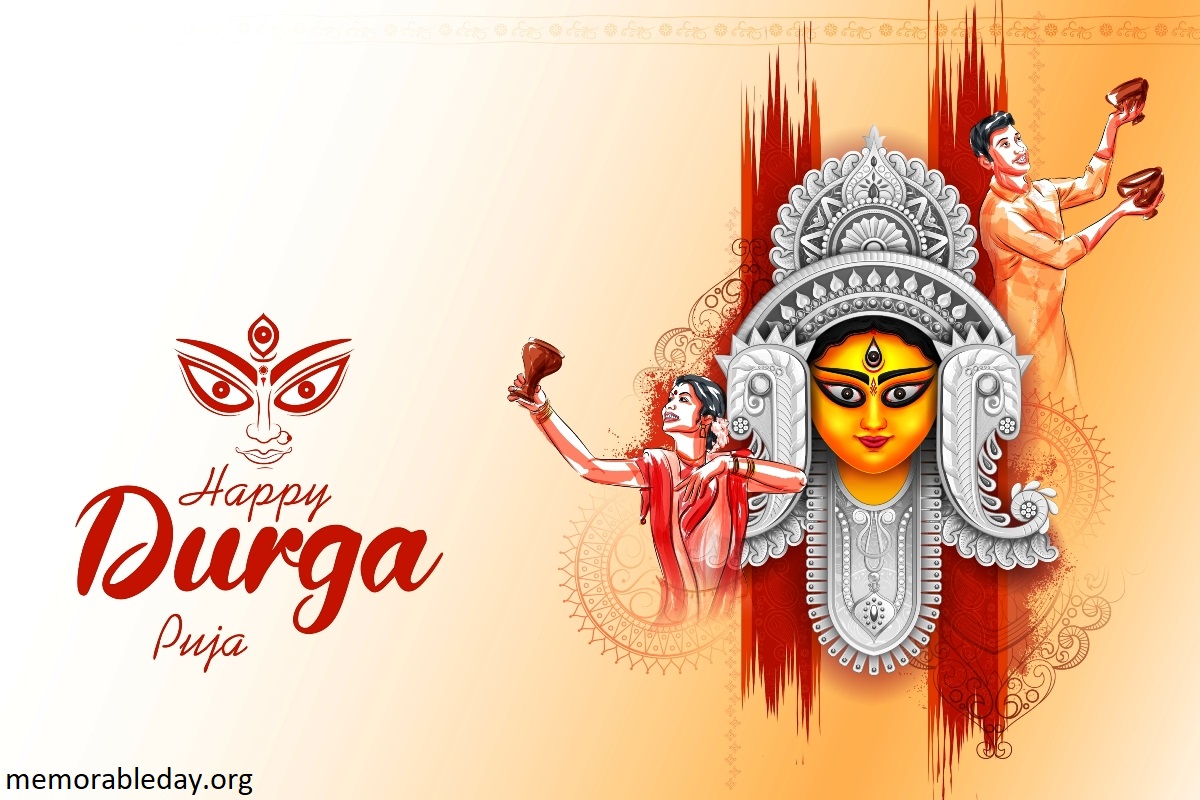
Durga Puja, one of the most significant Hindu festivals, is a grand celebration of the victory of good over evil. This vibrant festival is dedicated to Goddess Durga, who symbolizes power, strength, and protection. With elaborate rituals, artistic decorations, and cultural performances, Durga Puja unites people in devotion and festivity. As we approach October 10th, it’s time to immerse ourselves in the divine spirit of this auspicious occasion.
History of Durga Puja
The history of Durga Puja dates back to ancient times, deeply rooted in Hindu mythology. According to legend, the demon king Mahishasura was granted a boon that made him nearly invincible. However, his tyranny spread chaos across the heavens and earth. To restore peace, the gods combined their energies to create Goddess Durga. After a fierce battle, she vanquished Mahishasura, signifying the triumph of righteousness. Since then, Durga Puja has been celebrated with great fervor to honor her victory and seek her blessings.
Also Read: World Sight Day
When is Durga Puja Celebrated?
Durga Puja is observed in the Hindu lunar month of Ashwin, typically falling in September or October. In 2024, the festival will be celebrated from October 9th to October 13th, with Maha Navami and Vijaya Dashami taking place on October 12th and 13th, respectively. However, the most significant day for grand celebrations is October 10th, which marks Maha Saptami, the beginning of the main rituals and festivities.
How Do We Celebrate Durga Puja?
Durga Puja is a festival of devotion, art, and joy. Here’s how people celebrate this auspicious occasion:
- Pandal Hopping – Magnificently crafted pandals (temporary temples) are set up across cities, showcasing artistic depictions of Goddess Durga.
- Rituals and Aarti – Devotees participate in daily prayers, pushpanjali (flower offerings), and aarti to seek blessings.
- Cultural Programs – Dance, drama, and musical performances add to the festive spirit.
- Feasting on Bhog – Special dishes, including khichuri, luchi, and sweets, are offered to the deity and distributed as prasad.
- Sindoor Khela – On the final day, married women apply vermillion to each other, symbolizing prosperity and well-being.
- Visarjan (Immersion of Idols) – The festival concludes with the immersion of Durga’s idol in water, signifying her return to Mount Kailash.
Why is Durga Puja Celebrated?
Durga Puja is celebrated to honor the divine feminine energy that destroys evil forces and restores harmony. It is also a time to express gratitude for prosperity and well-being. More than a religious event, it has become a cultural extravaganza, bringing together people from all walks of life. The festival also promotes social harmony, artistic expression, and spiritual enlightenment.
Celebrate Durga Puja on October 10th
October 10th marks a crucial day in the Durga Puja celebrations. The air will be filled with devotion, joy, and enthusiasm as devotees gather to offer prayers and enjoy cultural festivities. It is the perfect time to embrace the spirit of togetherness, visit beautifully adorned pandals, and indulge in traditional delicacies. Let’s make this Durga Puja a memorable one by spreading love, positivity, and divine blessings.
Durga Puja Quotes
- “May Goddess Durga empower you with strength and wisdom.”
- “Durga Puja is not just a festival; it’s a feeling of joy and devotion.”
- “Let’s welcome Goddess Durga into our hearts with faith and love.”
- “The power of Durga is the power of goodness that resides within us.”
- “Celebrate this Durga Puja with joy, peace, and devotion.”
- “May this festival bring happiness and success into your life.”
- “Durga Puja is the time to let go of worries and embrace blessings.”
- “The divine presence of Durga Maa brings light and happiness.”
- “Let’s bow to the supreme goddess and seek her blessings.”
- “Victory of good over evil – that’s the essence of Durga Puja.”
- “May Maa Durga fill your life with love and prosperity.”
- “This festival reminds us that no darkness can defeat light.”
- “Faith, devotion, and love – that’s the spirit of Durga Puja.”
- “Let’s cherish the blessings of Maa Durga and spread positivity.”
- “The roar of the dhak marks the arrival of happiness.”
- “Durga Maa teaches us to be fearless and strong.”
- “Let’s celebrate the goddess who empowers us all.”
- “This festival is a reminder to always stand for what is right.”
- “May Durga Maa bless you with power, patience, and prosperity.”
- “Durga Puja is the perfect time to share love and kindness.”
Durga Puja Wishes
- “Wishing you a blessed and joyous Durga Puja!”
- “May this Durga Puja bring happiness to your family.”
- “Happy Durga Puja! Stay blessed always.”
- “Celebrate this festival with devotion and enthusiasm!”
- “May Goddess Durga shower her blessings upon you.”
- “Wishing you prosperity and success this Durga Puja.”
- “May your heart be filled with love and faith.”
- “Durga Maa bless you with happiness and wisdom.”
- “Wishing you strength and positivity this Puja.”
- “Let’s welcome Durga Maa with open hearts.”
- “May this festival bring you peace and joy.”
- “Stay happy and celebrate this Puja with love.”
- “Durga Maa protect you from all evils.”
- “Wishing you a spiritual and joyous Puja.”
- “Celebrate with laughter and devotion!”
- “Let’s spread love and joy this festive season.”
- “Durga Puja greetings to you and your family.”
- “May this Puja bring good fortune to all.”
- “Stay blessed and enjoy the festivities!”
- “Wishing you a divine and memorable Durga Puja!”
Durga Puja Greetings & Messages
- “May Goddess Durga guide you to success and happiness!”
- “Let’s celebrate the divine energy of Durga Maa.”
- “Durga Puja is here – let’s rejoice in devotion!”
- “May your life be filled with Maa Durga’s blessings.”
- “Sending you warm wishes this Durga Puja.”
- “Celebrate this Puja with faith and joy.”
- “May Durga Maa shower peace and prosperity.”
- “Wishing you happiness and health.”
- “Durga Puja is a time of togetherness!”
- “Let’s celebrate this divine occasion with love.”
- “May the spirit of Durga Puja uplift your soul.”
- “Sending positivity and prayers your way.”
- “Let’s cherish the blessings of Durga Maa.”
- “Durga Puja is a time to spread joy!”
- “Wishing you success and fulfillment.”
- “Stay blessed during this festive season!”
- “Let’s welcome Maa Durga into our lives.”
- “May this festival bring you endless joy.”
- “Sending heartfelt greetings your way.”
- “Wishing you strength, peace, and devotion this Durga Puja.”
Celebrate Durga Puja on October 10th with devotion, enthusiasm, and love!
Celebrate Durga Puja FAQs and answer
1. What is Durga Puja?
Durga Puja is a Hindu festival that celebrates the victory of Goddess Durga over the demon Mahishasura. It is a significant festival in India, especially in West Bengal, Odisha, Assam, and Tripura, as well as in Bangladesh and Nepal.
2. When is Durga Puja celebrated?
Durga Puja is observed during the Hindu month of Ashwin (September-October) over a span of ten days, with the last five days—Shashthi, Saptami, Ashtami, Navami, and Dashami—being the most significant.
3. Where is Durga Puja celebrated?
Durga Puja is widely celebrated in West Bengal, Odisha, Assam, Tripura, Bihar, and Jharkhand. It is also observed in major cities across India and in countries with Bengali communities, such as Bangladesh, the UK, the USA, and Canada.
4. Why is Durga Puja celebrated?
Durga Puja marks the triumph of good over evil. It symbolizes the power of Goddess Durga, who defeated the demon Mahishasura after a fierce battle that lasted nine days.
5. What are the main rituals of Durga Puja?
The key rituals include:
- Mahalaya – The beginning of Durga Puja, invoking the goddess.
- Bodhon – The ritual of welcoming Goddess Durga.
- Shashthi to Dashami – The five main days of Puja, involving prayers, chanting, and celebrations.
- Sindoor Khela – Married women apply vermilion to Goddess Durga and each other on Dashami.
- Visarjan – The immersion of the idol in water, marking the end of the festival.
6. What are the different forms of Goddess Durga worshipped?
During Durga Puja, Navadurga (nine forms of Durga) are worshipped, with Maha Ashtami being dedicated to Mahishasuramardini, the demon-slaying form.
7. What is ‘Pushpanjali’ in Durga Puja?
Pushpanjali is the flower offering ritual where devotees chant prayers and offer flowers to Goddess Durga, seeking her blessings.
8. How is Durga Puja celebrated?
Durga Puja is celebrated with grandeur, including:
- Pandal hopping (visiting decorated puja venues)
- Cultural performances (dance, music, and plays)
- Traditional bhog (prasad) distribution
- Sindoor Khela and Dhunuchi Naach (traditional dances)
9. What kind of food is eaten during Durga Puja?
Durga Puja features a variety of traditional Bengali dishes, such as:
- Bhog (Khichuri, Labra, Chutney, Payesh)
- Luchi with Cholar Dal
- Sweets like Sandesh, Rosogolla, and Mishti Doi
- Street food like Phuchka, Rolls, and Jhalmuri
10. How has Durga Puja evolved over time?
While traditionally a religious festival, Durga Puja has become a grand cultural event, with elaborate themed pandals, celebrity performances, and digital celebrations.
11. Can non-Hindus participate in Durga Puja?
Yes, Durga Puja is a community festival, and people from all religions and backgrounds are welcome to take part in the celebrations.
12. How is Durga Puja celebrated outside India?
Many Bengali communities across the world, including in the USA, UK, Canada, and Australia, organize Durga Puja with idols, rituals, and cultural programs.
13. What happens on Dashami (the last day)?
On Dashami, the idol of Goddess Durga is immersed in water (Visarjan), symbolizing her return to Mount Kailash. Families exchange sweets and touch elders’ feet for blessings.
14. What is the significance of Sindoor Khela?
Sindoor Khela is a ritual where married women apply vermilion to Goddess Durga and then to each other, symbolizing prosperity and marital bliss.
Would you like more details on a particular aspect of Durga Puja? 😊






